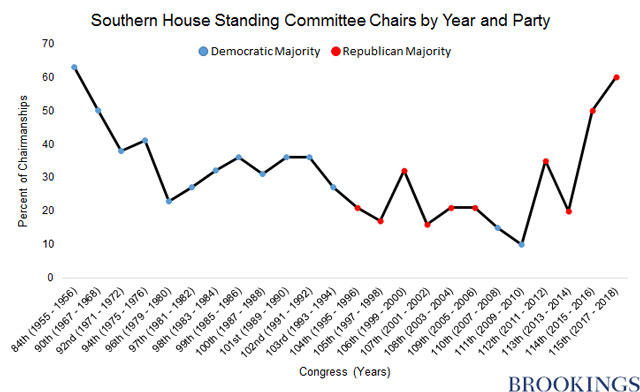Vital Statistics on Congress is a regular publication of the Brookings Institution. Since its first publication in 1980, it has become a go-to reference guide for those interested in congressional affairs. This blog is the first in a series that will highlight interesting data trends in each chapter of the most recent update, released January 2017.
The start of the 115th Congress brings several new House committee chairs, bringing the share of chairmanships held by members from southern states* to levels not seen since the 1950s. As the graph from Vital Statistics below demonstrates, of the 20 House standing committees, 12 are presently chaired by Southerners (This trend is driven largely by the Texas delegation, which accounts for 7 of those 12). Importantly, however, what this strong Southern showing means today is something much different than what it meant 60 years ago.

To start with the most obvious difference, southern members are no longer primarily Democrats. Scholars have attributed this shift in party support over the course of the 20th century to the parties’ changing platforms on racial issues, as well as, more recently, on a broader set of social issues. For example, Howard Smith, a Southern Democrat from Virginia, was a major impediment to the passage of the Civil Rights Act of 1964. As chairman of the House Rules Committee, which plays an important gatekeeping role with regards to bills reaching the floor, Smith refused to allow the bill out of committee to be considered by the whole House. It took the threat of a discharge petition—a rarely-used procedural tool for bringing bills out of committee—to convince Smith to report the bill to the floor. By contrast, it was Republican Bob Goodlatte, fellow Virginian and chairman of the House Judiciary Committee, who blocked efforts to strengthen the Voting Rights Act in the wake of the Shelby v. Holder Supreme Court decision in 2013. The opposition to civil rights legislation held by representatives from the South has not changed; the party that represents those views has.
During the period of Democratic control of the House from 1955 to 1994, the bulk of Democratic support shifted from southern states to the northeast and west coast. Democrats also adopted a caucus rule in 1971 that allowed them to consider any member for a chairmanship position, regardless of that member’s seniority. Therefore, at the same time as the overall number of southern Democrats in the House was declining, the junior members that were now coming from other areas of the country could bypass their more senior southern colleagues to be selected for chairmanships. The result was a marked decline in southern chairmanships during these years of Democratic control. It was only when Republicans regained control of the House that southerners were presented with the possibility of reasserting their presence in committee leadership.
But chairing a committee doesn’t necessarily mean what it used to. In the election of 1994, Republicans gained control of the House for the first time in decades. At the beginning of the 104th congress in 1995, newly appointed Speaker Newt Gingrich spearheaded a series of reforms to committee operations. These included six-year term limits for chairs of committees and subcommittees (applicable only to Republicans, though some Democrats have called for adoption of a similar rule), elimination of three standing committees, and a cap on the number of chairmanships one member could hold, among other reforms. As the figure below from Vital Statistics table 4-6 illustrates, between 1994 and 1995 this resulted in a significant drop in the number of members with two or more chairmanships.
| Congress (Years) | Party in majority | No. of majority party members in the House | No. of chair standing committees and subcommittees | No. with two or more chairmanships |
|---|---|---|---|---|
| 84th (1955-1956) | D | 232 | 63 | 18 |
| 90th (1967-1968) | D | 247 | 111 | 32 |
| 92nd (1971-1972) | D | 254 | 120 | 25 |
| 94th (1975-1976) | D | 289 | 142 | 24 |
| 96th (1979-1980) | D | 276 | 144 | 19 |
| 97th (1981-1982) | D | 243 | 121 | 16 |
| 98th (1983-1984) | D | 267 | 124 | 23 |
| 99th (1985-1986) | D | 253 | 129 | 27 |
| 100th (1987-1988) | D | 258 | 128 | 28 |
| 101st (1989-1990) | D | 260 | 134 | 26 |
| 102nd (1991-1992) | D | 267 | 130 | 25 |
| 103rd (1993-1994) | D | 258 | 113 | 19 |
| 104th (1995-1996) | R | 230 | 102 | 1 |
| 105th (1997-1998) | R | 227 | 101 | 4 |
| 106th (1999-2000) | R | 223 | 100 | 2 |
| 107th (2001-2002) | R | 221 | 108 | 1 |
| 108th (2003-2004) | R | 229 | 104 | 2 |
| 109th (2005-2006) | R | 231 | 109 | 3 |
| 110th (2007-2008) | D | 233 | 112 | 4 |
| 111th (2009-2010) | D | 256 | 115 | 2 |
| 112th (2011-2012) | R | 241 | 121 | 1 |
| 113th (2013-2014) | R | 232 | 111 | 4 |
| 114th (2015-2016) | R | 247 | 113 | 1 |
The consequence of this shift is twofold. First, with each member allowed fewer chair positions that were now term-limited, more junior members were given chairmanship opportunities. Members’ opportunities to influence the overall House policy agenda through their committee affiliations were also impacted, as their ability to build a history of leadership and influence in multiple committees was diminished. New rules also enhanced the authority of the speaker to select committee chairs and set the legislative priorities for the entire chamber. Taken together, these changes primed party leadership to become the brokers of power in the new congress.
Scholarship has since shown that is exactly what happened. Increased reliance on party leadership to accomplish legislative goals meant that committee chairs worked with leadership more than they worked with each other. This adjustment limited incentives to build close relationships between committees, making cooperation more difficult. Committees’ power to craft legislation under their own jurisdiction was also weakened, as any bill that was to be successful had to have the blessing of party leaders first.
Yet all is not lost for today’s cohort of Southern chairmen hoping to use their position to further Southern interests. Committee chairs still wield the power to set the agenda for legislation that falls under their jurisdiction. Chairs choose which bills will be heard, and in what order, meaning they can often keep legislation they do not support from ever being considered by the full chamber. Speaker Paul Ryan has also suggested that he would like to see a greater role for committees in originating legislation. In his first remarks after election as Speaker in 2015, Ryan said, “committees should retake the lead in drafting all major legislation. If you know the issue, you should write the bill.”
While the prevalence of Southern House committee chairs may not carry as much weight as it would have in the 1950s—or even the early 1990s—it is nonetheless sure to have an impact on the policy priorities of the 115th congress.
* Here, southern states include Alabama, Arkansas, Florida, Georgia, Louisiana, Mississippi, North Carolina, South Carolina, Tennessee, Texas, and Virginia






Commentary
Vital Stats: Southern congressmen are regaining committee chairmanships, but that means something different than it used to
January 17, 2017